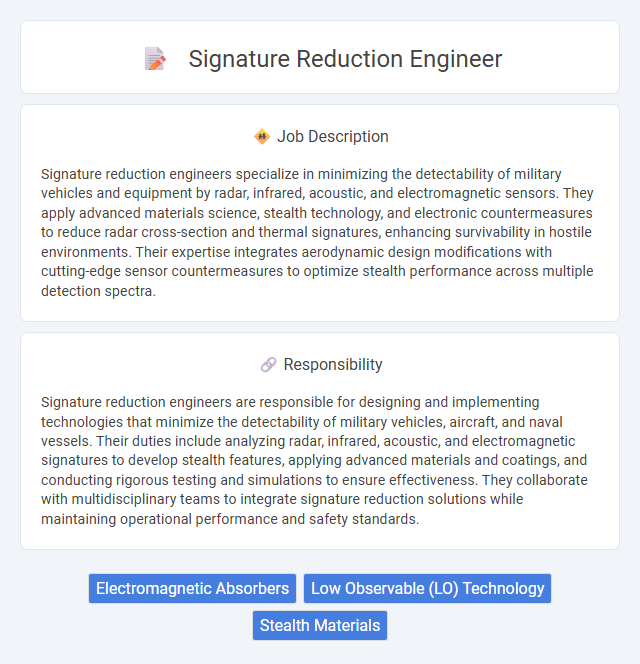
Signature reduction engineers specialize in minimizing the detectability of military vehicles and equipment by radar, infrared, acoustic, and electromagnetic sensors. They apply advanced materials science, stealth technology, and electronic countermeasures to reduce radar cross-section and thermal signatures, enhancing survivability in hostile environments. Their expertise integrates aerodynamic design modifications with cutting-edge sensor countermeasures to optimize stealth performance across multiple detection spectra.
Individuals with strong analytical skills and a keen interest in cybersecurity may be well-suited for a signature reduction engineer role. Candidates who enjoy problem-solving in high-pressure environments and have a background in computer science or network security are likely to excel. Those lacking attention to detail or struggling with complex technical concepts might find this position challenging.
Qualification
A Signature Reduction Engineer typically requires a strong background in aerospace engineering, electrical engineering, or physics, along with proficiency in electromagnetic theory and radar cross-section (RCS) analysis. Candidates should possess advanced skills in computational modeling software such as MATLAB, ANSYS HFSS, or CST Microwave Studio to simulate and minimize vehicle or system signatures. Experience with stealth technology, materials science related to radar-absorbing coatings, and knowledge of defense industry standards are essential qualifications for this role.
Responsibility
Signature reduction engineers are responsible for designing and implementing technologies that minimize the detectability of military vehicles, aircraft, and naval vessels. Their duties include analyzing radar, infrared, acoustic, and electromagnetic signatures to develop stealth features, applying advanced materials and coatings, and conducting rigorous testing and simulations to ensure effectiveness. They collaborate with multidisciplinary teams to integrate signature reduction solutions while maintaining operational performance and safety standards.
Benefit
Signature reduction engineers likely enhance stealth capabilities by minimizing detection probabilities through advanced technologies. Their work probably increases operational security and survivability for military assets and vehicles in contested environments. This specialization may offer strong career growth prospects due to rising demand in defense and aerospace industries.
Challenge
Signature reduction engineer roles likely involve tackling complex challenges related to minimizing detectability in radar, infrared, or acoustic systems. The position probably demands innovative problem-solving skills to develop and implement advanced materials and design techniques that reduce signal signatures. Candidates might frequently confront issues balancing performance, cost, and environmental factors while maintaining operational effectiveness.
Career Advancement
Signature reduction engineers specialize in minimizing detection by adversary systems through techniques such as radar cross-section reduction, electromagnetic interference control, and stealth technology integration. Career advancement typically involves progressing to senior engineering roles, leading multidisciplinary teams in cutting-edge defense projects, and contributing to research and development in stealth systems. Mastery of advanced simulation tools, strong project management skills, and expertise in materials science significantly enhance opportunities for promotion and leadership in this highly specialized field.
Key Terms
Electromagnetic Absorbers
Signature Reduction Engineers specializing in Electromagnetic Absorbers design and develop advanced materials to minimize radar and electromagnetic wave reflections on military and civilian platforms. Their expertise involves creating coatings and composites with tailored permittivity and permeability properties to absorb specific frequency ranges, enhancing stealth capabilities and reducing detection risks. Proficiency in computational electromagnetics, material science, and anechoic chamber testing is essential to optimize absorber performance and integration.
Low Observable (LO) Technology
Signature reduction engineers specializing in Low Observable (LO) technology develop advanced materials and design techniques to minimize radar, infrared, and acoustic signatures of military assets. They apply principles of stealth technology, including electromagnetic wave absorption and structural shaping, to enhance asset survivability and mission effectiveness. Expertise in computational modeling and testing ensures optimized performance of stealth solutions against evolving detection systems.
Stealth Materials
Signature reduction engineers specialize in designing and integrating stealth materials to minimize the detectability of military assets by radar, infrared, acoustic, and electromagnetic sensors. They develop advanced composites, radar-absorbent coatings, and thermal camouflage solutions to enhance the survivability and operational effectiveness of aircraft, naval vessels, and ground vehicles. Expertise in electromagnetic theory, material sciences, and stealth technology testing is essential to optimize the performance and durability of stealth materials in various operational environments.
 kuljobs.com
kuljobs.com